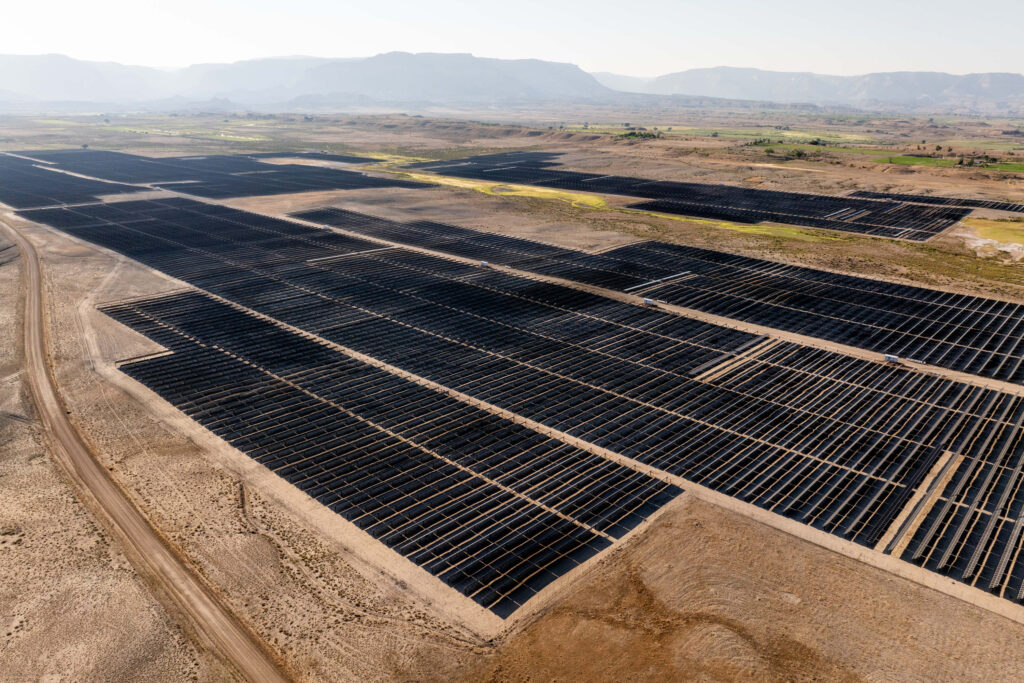A solar installation in Emery County is pictured on Wednesday, July 31, 2024. (Photo by Spenser Heaps for Utah News Dispatch)
The federal government released its updated plan to develop swaths of Western land for solar development, which could open up millions of acres in Utah controlled by the Bureau of Land Management for potential energy production.
The plan covers roughly 32 million acres in 11 Western states — Arizona, California, Colorado, Idaho, Montana, Nevada, New Mexico, Oregon, Utah, Washington and Wyoming.
In Utah, the BLM identified just over 5 million acres of land, more than all other Western states except Nevada, where about 11.8 million acres were highlighted.
Much of that land is technically already available for solar development, but the proposal — called the Western Solar Plan — is an attempt to streamline the permitting process for large projects by designating preferred sites. It would guide developers to areas that are near transmission lines or land that was previously disturbed, while steering them away from areas that could result in conflicts with other resources, like wildlife habitat or culturally sensitive sites.
The BLM said it would “provide greater predictability to the solar energy industry.”
In Utah, the bulk of the 5,010,256 acres highlighted are in the western half of the state, mostly in the West Desert. The BLM identified a chunk of land along Interstate 80 between Salt Lake City and the Nevada border, and other large patches in the central part of the state, west of Interstate 15 near Fillmore and Delta.
There are also areas surrounding Cedar City, with some remaining land identified near Hanksville in Wayne County, south of Vernal in the Uintah Basin, along Highway 6 near Price and north of Moab near Interstate 70.
A map showing land in Utah the Bureau of Land Management highlighted for its potential for solar energy. (Credit: Bureau of Land Management)
Just because land has been identified does not mean companies have a green light to start developing. Instead, the BLM calls it a “road map.” Each solar project will still require an additional environmental review and public comment, as required under the National Environmental Policy Act, or NEPA.
The plan, which was released on Aug. 30, will also be subject to a 30-day comment period and an additional 60-day review for governors to make sure the proposal is consistent with existing state plans.
The proposal seeks to update the 2012 Western Solar Plan, after President Joe Biden issued an executive order directing the Secretary of the Interior to review the permitting process for renewable energy projects on public land.
BLM Director Tracy Stone-Manning calls the plan “a responsible, pragmatic strategy for developing solar energy” that will boost domestic energy production.
“It will drive responsible solar development to locations with fewer potential conflicts while helping the nation transition to a clean energy economy,” Stone-Manning said in a statement.
But the plan has been met with pushback from states, industry and environmental groups, who all submitted public comments earlier in the year when the BLM was considering multiple alternatives.
Feds plan to open 32M acres of public land for solar development across 11 western states
In a letter to the BLM, Director of the Utah Public Lands Policy Coordinating Office Redge Johnson said the state “cannot in good faith support any of the five proposed alternatives.”
In the comment, Johnson said every alternative would conflict with grazing, impacting people who “have been ranching on BLM lands for decades.” Johnson also said the state was “very displeased with the BLM’s failure” to work with other state-level agencies.
The Utah Farm Bureau Federation, an organization of farmers and ranchers across the state, also opposed the BLM’s plans over similar concerns.
“We urge the BLM to approach development of utility-scale solar projects with caution to avoid unnecessary conflict and causing harm to agriculture and grazing,” the group wrote.
And the Center for Biological Diversity, in a recent news release, said the plan risked harming critical habitat for wildlife. Acknowledging large solar projects as “an important component of the clean energy transition,” the group cautioned unique species like the desert tortoises could be negatively impacted.
“We’re deeply disappointed that the Bureau of Land Management is putting energy developers ahead of wildlife and protected public lands,” said Randi Spivak, public lands policy director at the Center for Biological Diversity, in a statement. “There’s room on public lands for thoughtfully sited solar energy projects. We don’t need to destroy tens of millions of acres of wildlife habitat to achieve our clean energy goals.”
SUPPORT NEWS YOU TRUST.

